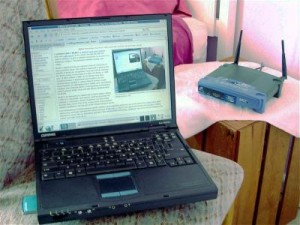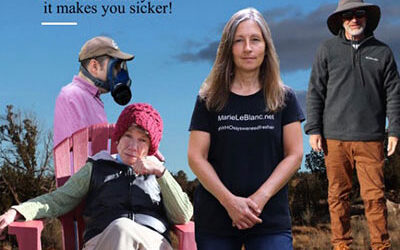by Ann and Torkel Atterbom
(translated from Swedish)
 We finally discovered the reason for the months of constant headaches and sleep problems. The neighbors had installed wireless networks and we started a massive information campaign to get them turned off.
We finally discovered the reason for the months of constant headaches and sleep problems. The neighbors had installed wireless networks and we started a massive information campaign to get them turned off.
During a trip to Germany in the fall of 2007, Ann visited a clinic which used a provocation test to verify that her body reacted strongly to wireless networks (Wlan). When returning to our home environment, which is located where the signals from the surrounding cell towers are low, we fully expected her to recover from the trip. But not this time. Surprisingly, Ann felt worse and by the fall of 2008 the headaches were constant and it was impossible to sleep without a sleeping pill.
When Torkel eventually turned on the wireless network function on his laptop computer and walked around the garden to check for signals, it showed that the six neighbors had no less than nine wireless networks operating. Then it was no longer a mystery why Ann didn’t get better.
Our strategy became:
* First, to work at finding the resolve to say: “We’re gonna solve this one!” Without this, we probably would not have succeeded.
* To measure and document the name and signal strength of each wireless network, using Torkel’s computer. The combined signal strength varied a lot between different parts of the yard.
* To write a letter to the neighbors with information about electromagnetic hypersensitivity as a disability, the symptoms Ann gets from the wireless networks, how restricted her life is, and that each wireless router constantly transmits ten pulses each second, even in stand-by mode. We also wrote that several authorities recommend not using wireless networks and that many schools and libraries have turned them off.
* To personally meet with each neighbor, show them the documentation, and leave them with the letter to consider at their leisure.
* To ask the local county officials to mediate, a task we never needed to do.
Every neighbor was surprised – they had never heard that wireless networks could be dangerous.
One 35-year-old neighbor was on sick leave for depression and their cats had been so stressed they had been put to sleep. Another neighbor had the router located in the bedroom and had a nervous tick in the face.
Some of them turned off their networks immediately, and installed cables instead. One lowered the signal strength and moved the antennas.
Two neighbors remained, who thought it was all in our imagination. They had asked the vendor, who told them that nobody can have a problem with such low levels of radiation. They had a total of four networks, which they also used to transmit internet-telephone calls between them, using a very focused beam that went right through our house. The one neighboring couple both works in the health care system, which made things more difficult – they were the “experts” and they already “knew” all about what was a health risk and what wasn’t.
Despite all our efforts and massive amounts of information, we never succeeded convincing the two remaining neighbors and Ann had to move away in December.
Then we got saved by the closest neighbor selling the house, since he was chronically tired and unable to keep up his house and yard (he was 51 years old). When the next owners were told about the problem, they turned off the network the last neighbor used for internet telephone. Then, the day before Christmas 2008, we got the best Christmas present possible: the last wireless network was turned off and we could, against all odds, celebrate Christmas at home.
This article was originally published in the 2009/3 issue of Ljusglimten, a publication of FEB, the Swedish organization for people with electromagnetic hypersensitivity.









0 Comments